

Nano Cpx flying 3d with transmitter behind back. How to clean up oil spills. MIT researchers have developed a new technique for magnetically separating oil and water that could be used to clean up oil spills.

They believe that, with their technique, the oil could be recovered for use, offsetting much of the cost of cleanup. The researchers will present their work at the International Conference on Magnetic Fluids in January. Shahriar Khushrushahi, a postdoc in MIT’s Department of Electrical Engineering and Computer Science, is lead author on the paper, joined by Markus Zahn, the Thomas and Gerd Perkins Professor of Electrical Engineering, and T. Alan Hatton, the Ralph Landau Professor of Chemical Engineering.
The team has also filed two patents on its work. In the MIT researchers’ scheme, water-repellent ferrous nanoparticles would be mixed with the oil, which could then be separated from the water using magnets. This approach can work if the concentration of the ferrofluid is known in advance and remains constant. Orthogonal thinking Leaving the lab. 3D-printer with nano-precision. Printing three dimensional objects with incredibly fine details is now possible using "two-photon lithography".
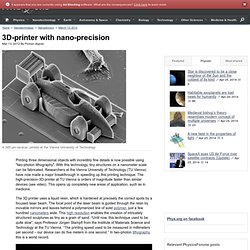
New 3D printer could create nano-devices in minutes. Researchers at the Vienna University of Technology (TU Vienna) have developed a 3D printing technology that can quickly print detailed objects in nanoscale using a process called two-photon lithography. Energy. A recent breakthrough by scientists from NUS and University College Cork may mean the arrival of highly energy-efficient smart phones and tablets that can last up to 10 times their usual life.
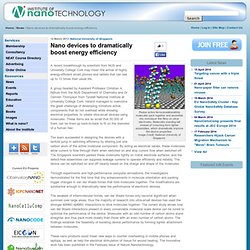
A group headed by Assistant Professor Christian A Nijhuis from the NUS Department of Chemistry and Dr Damien Thompson from Tyndall National Institute at University College Cork, Ireland managed to overcome the great challenge of developing miniature active components that do not overheat while showing electrical properties, to create ultra-small devices using molecules. These items are so small that 50,000 of them can be lined up back-to-back to fit on the diameter of a human hair. The team succeeded in designing the devices with a tenfold jump in switching efficiency by altering just one carbon atom of the active molecular component.
By acting as electrical valves, these molecules allow current to flow through them when switched on and stop current flow when switched off. A Hybrid Nano-Energy Harvester. Nanofactory Collaboration. Molecular Manufacturing. What is Molecular Manufacturing?
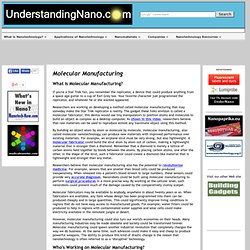
If you're a Star Trek fan, you remember the replicator, a device that could produce anything from a space age guitar to a cup of Earl Grey tea. Your favorite character just programmed the replicator, and whatever he or she wanted appeared. Researchers are working on developing a method called molecular manufacturing that may someday make the Star Trek replicator a reality. The gadget these folks envision is called a molecular fabricator; this device would use tiny manipulators to position atoms and molecules to build an object as complex as a desktop computer. As shown in this video, researchers believe that raw materials can be used to reproduce almost any inanimate object using this method. By building an object atom by atom or molecule by molecule, molecular manufacturing, also called molecular nanotechnology, can produce new materials with improved performance over existing materials.
Nanotechnology: CRN Glossary. Nanotechnology: Benefits of Molecular Manufacturing. Solar-powered nanofilters pump in antibiotics to clean contaminated water. Using the mechanism bacteria use to shrug off powerful antibiotics, scientists have developed solar-powered nanofilters that remove antibiotics from lakes and rivers twice as efficiently as the best existing technology.

Credit: American Chemical SocietyUsing the same devious mechanism that enables some bacteria to shrug off powerful antibiotics, scientists have developed solar-powered nanofilters that remove antibiotics from the water in lakes and rivers twice as efficiently as the best existing technology. Their report appears in ACS’ journal NanoLetters. Hybrid Nanogenerator-Biofuel Cell. 4 in Share Energy harvesting continues to be an exceedingly important issue, not only with regard to global energy consumption but also in terms of powering implantable medical devices.
Unlike options for the societal level, which include solar and thermal power collection, potential energy reservoirs within the body are currently confined to mechanical and biochemical sources (i.e. photons cannot reach solar cells that are implanted beneath the skin, and there is not a sufficient thermal gradient within the body to tap into).
Flexible Sheets Capture Energy from Movement. Researchers at Princeton University have created a flexible material that harvests record amounts of energy when stressed.
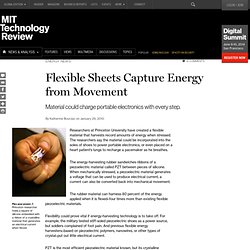
The researchers say the material could be incorporated into the soles of shoes to power portable electronics, or even placed on a heart patient’s lungs to recharge a pacemaker as he breathes. The energy-harvesting rubber sandwiches ribbons of a piezoelectric material called PZT between pieces of silicone. When mechanically stressed, a piezoelectric material generates a voltage that can be used to produce electrical current; a current can also be converted back into mechanical movement. The rubber material can harness 80 percent of the energy applied when it is flexed–four times more than existing flexible piezoelectric materials. Agriculture. “What would happen if we could arrange the atoms one by one the way we want them?”

Asked Richard Feynman, a well-known American physicist, in his speech during the meeting of the American Physical Society in 29 December 1959.1 This idea eventually became a research field known as nanotechnology. Nanotechnology refers to controlling, building, and restructuring materials and devices on the scale of atoms and molecules.2 A nanometer (nm) is one-billionth of a meter. Nanotechnology in Agriculture.
By Will Soutter Topics Covered Introduction Precision Farming Nano Delivery Systems Nanotechnology in Food Recent Developments Conclusion Sources.

Viable Lab on a Chip. The way doctors do diagnosis could change soon.
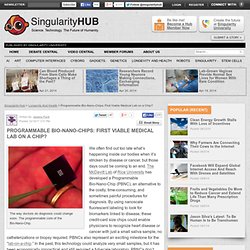
The programmable core of the Bio-Nano-Chip. We often find out too late what’s happening inside our bodies when it’s stricken by disease or cancer, but those days could be coming to an end. The McDevitt Lab of Rice University has developed a Programmable Bio-Nano-Chip (PBNC), an alternative to the costly, time-consuming, and sometimes painful procedures for diagnosis.
By using nanoscale fluorescent labeling to look for biomarkers linked to disease, these credit-card size chips could enable physicians to recognize heart disease or cancer with just a small saliva sample, no catheterizations or biopsy required. Nanomotors. Enzymes, workhorse molecules of life that underpin almost every biological process, may have a new role as "intelligent" micro- and nanomotors with applications in medicine, engineering and other fields.
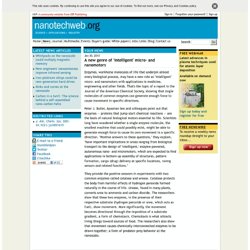
That's the topic of a report in the Journal of the American Chemical Society, showing that single molecules of common enzymes can generate enough force to cause movement in specific directions. Peter J. Butler, Ayusman Sen and colleagues point out that enzymes — proteins that jump-start chemical reactions — are the basis of natural biological motors essential to life. Scientists long have wondered whether a single enzyme molecule, the smallest machine that could possibly exist, might be able to generate enough force to cause its own movement in a specific direction. They provide the positive answers in experiments with two common enzymes called catalase and urease. Micro- and nanomotors powered by water as the sole fuel source (w/video)
Autonomous nanomotor based on a true nanobattery. Speeding up catalytic nanomotors with carbon nanotubes. Here come the nanocars. Rice University has concocted the ultimate in high-tech vehicles. They drive on roads of solid gold and are made from a relatively small number of carbon atoms. The university's nanocars, which will be described in an upcoming issue of the journal Nano Letters , are actually complex molecules that behave like vehicles.
They roll on wheels and can be steered with electrical fields or by other means. Concept nanocars - off to the races? NANO CARS INTO THE ROBOTICS FOR THE REALISTIC MOVEMENTS. Molecular Switches. The switch on the wall turns on the light; flip it the other way and the room goes dark. Now imagine such a switch, but on a molecular level. This is not science fiction. Molecular switches are a high priority for the National Science Foundation (NSF), high enough to award $650,000 to Ivan Aprahamian for five years of basic science research at Dartmouth. Dartmouth Assistant Professor of Chemistry and special NSF award recipient Ivan Aprahamian investigates the science and utility of nanoscale machines. What is a Molecular Switch? By Will Soutter Topics Covered Introduction Miniaturization of Electronics The "Bottom-Up" Approach Molecular Switches Types of Molecular Switch Crown Ether Switches Rotaxanes Photochromic Switches Nanoparticle Switches Current State of Molecular Switch Research References Introduction.
Benefits and Applications. After more than 20 years of basic nanoscience research and 10 years of focused R&D under the NNI, applications of nanotechnology are delivering in both expected and unexpected ways on nanotechnology’s promise to benefit society. Nanotechnology is helping to considerably improve, even revolutionize, many technology and industry sectors: information technology, energy, environmental science, medicine, homeland security, food safety, and transportation, among many others.
Molecular Shuttles. Nano microphone. Scientists create the most sensitive listening device ever. Dendrimers. Genetically Encoded Biosensors. Nano transmitters. Quantum Dots. Quantum Dots & Nanoparticles. Applications of Quantum Dots. Nanoco’s CFQD® quantum dots offer enhanced colour, energy efficiency, and seamless integration into existing production processes. Molecular tweezers (drug delivery) Optical Tweezers Introduction. The Basics. Molecular Manufacturing. Nanofactory Movie. Nanobot Assembly Line.
Microbivore & Chromallocyte. The founder of the Nanofactory Collaboration is innovating medicine molecule by molecule. By Robert A. Freitas Jr. Self Powering. Self-Powered Nanosensors. Networking and Self- Synchronizing. First self-powered transmiter. Nano Generator. What can we do with them? Propeller + Arm + Motor. "It is a staggeringly small world that is below," Richard Feynman said in his famous 1959 speech about nanotechnology, There¿s Plenty of Room at the Bottom. "In the year 2000, when they look back at this age, they will wonder why it was not until the year 1960 that anybody began seriously to move in this direction. "
Nano Robots. Nanotechnology In Medicine (Nanorobots, nanofactories) The rise of molecular robots. Advanced Drug Delivery (MEND) MEND terminology. DNA Origami. Self Assembled DNA Structures. Self-assembling nanodevices. Robot Kills Cancer. Military Applications. Bomb-Sniffing. Military nanotechnology - how worried should we be?